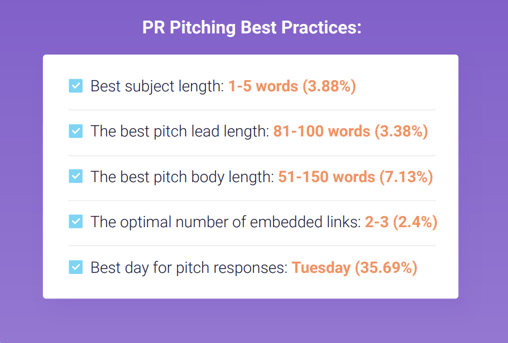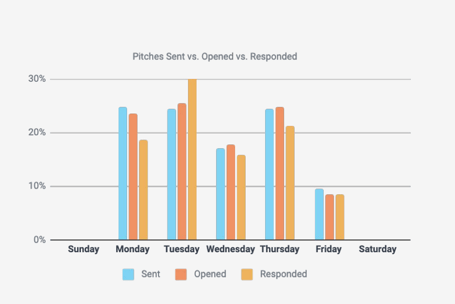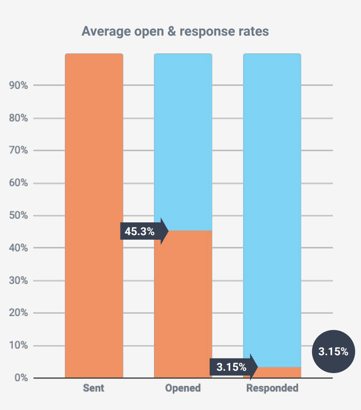Secure media attention amid mass journalist layoffs, a saturated pitching environment, and the rise of new media.
 The journalism industry is in a constant state of evolution, and the current media climate is harder to navigate than ever. Even after you’ve crafted the perfect story that is novel, timely, and relevant to a publication’s target audience, you might still be left scratching your head waiting for a reply.
The journalism industry is in a constant state of evolution, and the current media climate is harder to navigate than ever. Even after you’ve crafted the perfect story that is novel, timely, and relevant to a publication’s target audience, you might still be left scratching your head waiting for a reply.
A Propel media barometer report details what pitches reporters are responding to, what gets left unread, the best days to pitch, and more supported with industry data.
Let’s see what works and what doesn’t in today’s newsroom.
Audio: Listen to this article.
Writing the perfect pitch
Every journalist has their unique perception of a “perfect pitch” — some would prefer you keep it short and to the point; others will want all the information relevant to the story in that first email. Most prefer email, but, occasionally, a reporter will request pitches via social, Slack, or phone.
Here’s what the data tells us is your best shot to make sure your email gets opened:
-
Keep your subject lines short.
The data echoes what we’ve always anecdotally heard from reporters — keep your subject lines between one and five words. It’s your first chance to grab their attention, and there’s a good chance that if it doesn’t, they won’t click through to the rest of your email.
The report confirmed subject lines of between one and five words had the highest response rate (3.88%). You might be thinking that 3% doesn’t sound like a high response rate, which goes to show how hard it is to break through the noise and how critical every piece of the pitch is to increase your success rate.
-
Be concise.
The rest of your pitch should jump right to the point. Lead with why your story is newsworthy and why the reporter should cover it now. The data found that pitches between 51 and 150 words saw the highest response rate at 7.13%, compared to pitches between 501 and 1,000 words that saw only a 1.45% response rate.
- Pitch timely topics.
Whether you have big news to share about your organization, such as a partnership announcement, a product launch, or an interesting take on a buzzworthy topic like AI or economic trends, remember timely topics will always take priority.
To paint the picture with numbers, generative AI is no doubt one of the leading topics of discussion across industries. The report revealed pitches mentioning artificial intelligence continue to garner reporter attention, noting a 156% uptick in the response rate for pitches mentioning AI from the previous quarter.

(Graphic credit: Propel report)
The best time to send a pitch
We live in a 24/7 news cycle. Reporters are writing and publishing stories around the clock, reacting to breaking news, tracking updates on social media, and managing cyclical news schedules for print editions, podcast drop dates, newsletters, and broadcast news. There is no specific science to time a pitch when you’ll certainly catch a reporter “at a good time.”
However, there are better times than others to make sure your email doesn’t get lost in the shuffle.
-
Days of the week
Tuesday is the best day of the week to take advantage of reporter engagement. The data shows 25% of all pitch opens and about 35% of journalism responses came through on Tuesday. Then, there’s a dip in engagement on Wednesday, with pitches sent recording the second lowest journalist response rate just shy of 16%. While Monday is also a higher engagement day, it’s also the most popular pitching day, with 24.67% of all pitches going out on Mondays. In this case, you’re competing with more noise.

(Graphic credit: Propel report
-
Time of day
Prioritize media pitching in the morning. While Propel didn’t share findings on what time of day is best to pitch, Muck Rack surveyed over 2,000 journalists for its 2023 State of Journalism and found that 61% of journalists prefer receiving PR pitches before noon. More specifically, 34% of journalists reported they prefer to receive pitches between 6 a.m. and 9 a.m., and another 34% prefer between 9 a.m. and 12 p.m.
-
Time of the year
If you’re planning a big announcement you’re anticipating to take over the headlines, it’s also important to consider the time of year your news will go live to avoid losing the media moment to predictable media lulls. For example, the report unsurprisingly caught a 5% dip in journalist responses between Q3 and Q4 2023, which regularly happens in line with the holiday season. You also want to avoid competing with major media moments that will consume the news cycle –– for example, election milestones or large industry events media regularly attend.
The rise of new media
How does engagement differ when pitching new forms of media, like podcasts and social media influencers, compared to traditional print media or broadcast channels?
The report revealed a few interesting findings:
-
PR pros are targeting podcasts.
It’s no secret podcasts have become a heavily utilized source of media. Listeners can follow podcasts tailored specifically to their interests, and the exposure of being featured as a guest on those key industry podcasts is invaluable.
The data puts that demand in perspective: Between Q3 and Q4 2023, podcasts received a 22% uptick in PR pitches, a continuation of a steady trend recognizing the medium’s growing popularity. The number of pitches podcasters received increased by 45% throughout 2023. However, as podcasters are inundated with PR pitches, the response rates are gradually falling, dropping to 13% in Q4.
-
Influencer engagement is ascending.
If your organization hasn’t considered influencer relations as a tool, maybe you should be. More and more people are looking to influencers as a trusted source for product reviews and unbiased feedback on organizations and experiences. On top of that, influencers have a stronger response rate than traditional media, with a 91% open rate and a 28% response rate.
Navigating the current state of journalism
Perhaps the most critical factor impacting your media outreach success rate is the shock wave caused by mass newsroom layoffs at the national, state, and local levels. Newsrooms are shrinking at alarming rates. The staff spared is now being stretched thin across multiple beats and content mediums to keep up with the demand of the 24/7 news cycle.
The legacy business models the news industry has depended on for decades are in a rapid state of change. In response, PR tactics are changing, too.
Here are a few things to keep in mind when engaging with the media during this evolution:
-
Lead with empathy.
The number of pitches incoming is the same (if not increasing), and the number of journalists is decreasing. Keep that in mind when considering what news you’re sharing, how you choose to follow up, and your expectations for a timely and thorough response. It’s more important than ever to do the due diligence and ensure you’re sending relevant news to the right reporter for that story while tailoring your pitch accordingly.
If you’re wondering if they’ve seen your pitch and when to follow up, the report revealed a majority of journalists open pitches within four hours of receiving the email, and 59% of the responses will occur within that same 4-hour window. Following up a day or two after sending pressing news would likely be standard practice.
-
Reporters are getting pickier.
Even if a publication or a reporter regularly covered a certain “type of news” a year ago, they might no longer have the capacity to cover the same type of news with a skeleton crew. To show this in numbers, the data revealed in Q4 2023, journalists opened 45% of pitches but only responded to 3%. If there’s no response, it doesn’t necessarily mean they didn’t see your email. Only a small fraction –– likely those stories moving forward immediately –– are getting a reply back.

(Graphic credit: Propel report
-
Breaking news vs. evergreen stories
Follow-up strategies and expectations for speedy coverage will vary depending on whether you’re pitching breaking news or something more evergreen. About 65% of the time, news stories will go from print to publication within three days of the initial pitch being sent. That timeline likely won’t be as swift for something less timely as reporters take on more work and prioritize getting breaking news out the door.
Interested in talking more about how to apply these best practices and data insights to see your stories told in the earned media landscape? Set up a one-on-one consultation with us today to fine-tune your media strategy.
Topics: media relations, earned media, news media


Comment on This Article